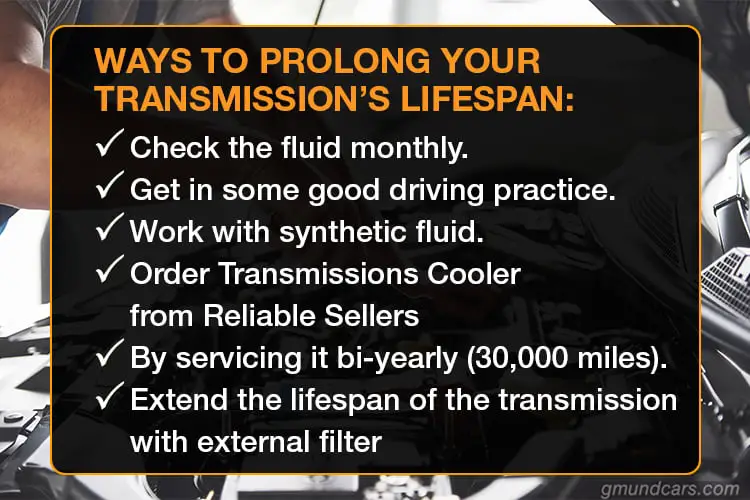Are you a driver unsure about your car’s maintenance or pondering, “what is the lifespan of a transmission?” It is worth noting that numerous factors must be accounted for before this question can be conclusively answered.
Need tools for your project? Toolbox, a tool rental marketplace, might be worth a look.
Ideally, your transmission should outlast your car. It is the second most expensive component of your car, and replacing it may be pricey. Even so, many drivers in the U.S. often report transmission failure before the vehicle’s breakdown.
Being more prepared for problems with the transmission can enhance your driving experience. So, let’s dive into how long does transmission last.
What Is A Transmission?
The transmission is a vital section of any car, transferring the engine’s power to the wheels.
It’s often situated to one side or the other, in line with the oil pan and a little lower than the engine. Do you own a rear-wheel car? Then, it’s beneath it or generally below the dashboard.
Manual, automatic, dual-clutch, and CVT transmissions are the four kinds of transmissions available. Here, each is tailored for unique purposes and driving styles.

What Determines Your Transmission’s Life Expectancy?
To address the question of “how long does transmission last,” let’s see what determines its lifetime.
While it’s a heady mix, a driver can predict the answer to a certain degree. He may consider the build quality and maintenance interval. Other factors worth considering include:
- Heat
- Lubrication
- Fate
- Circumstances
Simply put, the transmission’s lifetime depends on the maintenance intervals, how you drive, the type of vehicle, and brand. The area where you use the vehicle also determines its lifetime.
Read more: CVT Transmission Vs. Automatic Transmission
How Long Does Transmission Last?
How well you maintain your vehicle affects the transmission’s life. Of course, there is no predetermined time or mileage.
Some transmissions may stop working after 100,000 miles if they are not properly maintained. It could last for 300,000 miles with proper maintenance. Furthermore, the longevity of the two types of transmissions – manual and automatic – differs.
The table below notes the expected Life expectancy for various transmissions (years and miles covered).
| Types | Lifespan (miles and years) |
|---|---|
| Manual Transmission | Over 120,000 miles About 6 years |
| Automatic Transmission | 150,000–200,000 miles 7-9 years |
| CVT transmission | At least 100,000 miles About 5 years |
| Dual-clutch transmission | At least 200,000 miles Over 10 years |
Note that the answers here are only estimates and may differ across vehicles.
Read more: Bad Torque Converter Vs. Bad Transmission
How To Prolong Your Transmission’s Lifespan?
While there are many ways to prolong the lifespan of your transmission, the approaches slightly differ from car to car. But some tips may work with most cars and transmissions. Below are the 6 best ways to extend your transmission’s life expectancy.

1. Check The Fluid Monthly
Transmission fluid cools and lubricates while transmitting force and pressure and avoids buildup. As a result, checking your transmission fluid is a guaranteed way to extend its life.
As the transmission fluid ages, it may become depleted or include pollutants. When one of these things occurs, it might cause typical transmission issues like overheating. However, overheating may be prevented if you know when to completely replenish or replace the fluid.
2. Get In Some Good Driving Practice
Continuously accelerating and decelerating, or driving forcefully from a stop, produces a lot of heat. So, if you want to prolong the life of your transmission, ease up on the gas pedal and plan your movements ahead of time. As a result, the transmission will be less stressed, and you will arrive at your destination at around the same time.
3. Work With Synthetic Fluid
Synthetic fluids are more resistant to cold, heat, oxidation, and shearing, for starters. As a result, synthetic fluid is the best choice if you want your transmission to last longer. The synthetic fluid that is heat resistant will assist an older transmission to maintain high function over time.
4. Order Transmissions Cooler From Reliable Sellers
Heat is the leading killer of transmissions. Friction generates heat when pieces move around, causing long-term damage.
When the working temperature exceeds 200°F, every 20°F decreases the service life by 2. A decent transmission cooler may reduce the working temperature of the transmission by up to 2-3 times, allowing it to last longer.
5. Prolong The Transmission’s Life By Servicing It Bi-yearly (30,000 miles)
Getting your performance transmission serviced every two years, or 30,000 miles, is another way to extend its life. Changing the transmission fluid is one of the most effective maintenance operations performed on your vehicle throughout the service process.
6. Extend The Lifespan Of The Transmission With External Filters.
An external filter for the cooler lines may help keep dirt out of the fluid. Here, the original filter may not clear all the particles it encounters. So, an external filter helps it perform better. Thus, you can enjoy a smooth trip across the United States with a working transmission.
Read more: Transmission leak: Symptoms, causes and repair guide
FAQs
1. How often do transmissions need to be replaced?
How can you determine how often to replace transmissions? It’s simple. The age or mileage of the transmission is one of the most important factors to consider. For example, automatic transmissions fail after 7 years (150,000 miles). Manual transmissions can fail even sooner (5–6 years), especially if routine maintenance is not performed.
2. How long can you drive a car with a bad transmission?
Is your transmission severely messed up? If so, you must replace or rebuild it. But if the transmission still seems safe to drive, drive till about 150 miles from people before it completely stops working, leaving you with a 150-mile pull expense plus service fees.
Sadly, driving a car with a bad transmission is not recommended. If you know your automobile needs to be serviced, avoid driving it. Otherwise, prolonged use of a bad transmission only adds to the repair costs when servicing your car.
3. How long does a rebuilt transmission last?
A rebuilt transmission may last anywhere from 30,000 to 50,000 miles on average. A transmission rebuild may last as long as you do the original transmission (120,000–200,000 miles). Also, ensure routine maintenance.
4. Are rebuilt transmissions reliable?
Yes, rebuilt transmissions are unquestionably reliable quality. Furthermore, each item is removed and checked for future wear throughout the disassembly process. When a component is discovered to be faulty, it is replaced. This makes rebuilt transmissions reliable and efficient.